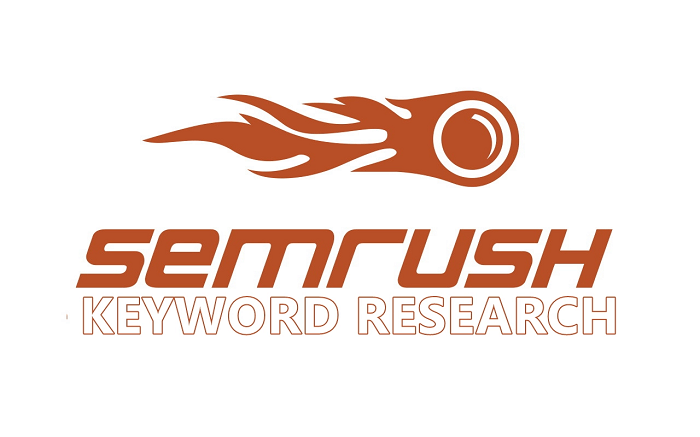Semrush Keyword Research
Semrush is a comprehensive digital marketing tool with several features to assist companies in enhancing their online presence. Semrush's keyword research tool, which enables companies to find pertinent keywords to focus on in their digital marketing campaigns, is one of its most crucial features.

What is Keyword Research?
Keywords are terms that people use to discover information in search engines. Examining these search phrases to understand where the search traffic in your market originates from and which keywords your website may target with marketing is known as keyword research. You may benefit from keyword research in the following ways:
- Recognize and reach out to your target audience.
- Discover new relevant subjects to discuss on your website and generate quality leads.
- Increase your sales.
- Increase ad campaign clicks and impressions.
- Increase brand awareness.
Why Should You Use Keyword Research Regularly?
- Keywords fluctuate because there are always various ways to describe the same thing, and trends frequently modify the queries people look for online.
- Your audience develops and changes, as does how people use search engines.
- Search engines also change; algorithms get more sophisticated to interpret material better and match users' intent.
- To stay updated, you must continually update your material.
Semrush Keyword Research

Any successful digital marketing plan must include keyword research as a key component. Businesses may optimize their website and online content to increase their visibility in Search Engine Results Pages (SERPs) and attract more relevant traffic by knowing the search phrases people use to locate items or services connected to their business.
Various features and functionalities are available in the keyword research tool from Semrush to assist businesses in locating pertinent keywords and search engine optimization of their content. We'll look at the many aspects of Semrush's keyword research tool in this post and how businesses can utilize them to strengthen their online presence.
1. Keyword Overview
In Semrush keyword research, the keyword overview section is one of the tool's most important and comprehensive parts. This section gives a high-level overview of every term, including its search traffic, keyword difficulty, and other critical data that can aid in the identification of high-value keywords for a website or campaign. Semrush's keyword summary page is broken into several parts, each providing vital information about the term. This section includes-
- Overview: The overview section summarizes the keyword, including its search volume, keyword difficulty, and trend statistics. The search volume estimates how many times a month the term is searched. The keyword difficulty score indicates how tough it is to rank for a term, with a higher score suggesting more competition. The trend data illustrates how the keyword's search volume has varied.
- SERP Analysis: The SERP analysis section shows the keyword's top organic and paid search results. This section also includes important metrics such as each result's number of backlinks, domain authority, and page authority. These indicators can assist in determining the amount of competition for the keyword and provide insight into the sort of content that performs highly for that keyword.
- Related Keywords: The related keywords section displays other keywords linked to the under consideration. These keywords may have similar search intent and can provide additional ideas for content and targeting.
- Phrase Match Keywords: The phrase match keywords section shows other keywords that contain the exact keyword or a variation. These keywords can be useful for creating long-tail keyword targeting strategies.
- Related Questions: The related questions section shows the most commonly asked questions related to the keyword. These questions can help create content that answers common queries related to the keyword.
- Top Pages: The top pages section shows the pages ranking in the top 20 search results for the keyword. This can provide insights into the type of content that ranks well for the keyword and can help create similar content.
- CPC Map: The CPC map section shows the cost per click (CPC) for the keyword in different countries. This can help identify the most valuable markets for the keyword and create location-based targeting strategies.
2. Keyword Magic Tool
One of Semrush's most potent tools for keyword research is the Keyword Magic Tool. This all-inclusive keyword research tool allows users to discover new keywords, examine search volumes, and uncover similar keyword phrases. The Keyword Magic Tool has gained popularity among SEO specialists, content marketers, and PPC advertisers due to its user-friendly design and sophisticated features. Here are some of the Keyword Magic Tool's salient characteristics:
- Keyword Research: The Keyword Magic Tool enables users to do keyword research based on various variables, including search volume, term difficulty, and more. Users may use the tool to produce a list of similar keywords by entering a seed or list of keywords. A simple table structure presents the findings, with columns for search volume, CPC, and keyword difficulty.
- Keyword Difficulty Analysis: The Keyword Magic Tool makes it simple to assess the difficulty of ranking for particular keywords. Keyword difficulty analysis is crucial to any keyword research tool. The program provides a keyword difficulty score ranging from 0 to 100, with higher numbers suggesting more competition. For the top 10 search results, this score considers elements including the number of backlinks, domain authority, and page authority.
- Related Keyword Suggestions: Magic Tool may list related keywords based on the user-entered seed term or phrase. This capability makes finding long-tail keyword phrases that may be utilized to target certain audiences easier.
- Grouping of Keywords: One of the unique features of the Keyword Magic Tool is its ability to group related keywords into clusters. This allows users to identify keyword themes and create more targeted content quickly. The tool also makes it easy to export these keyword groups into a CSV or Excel file for further analysis.
- Integration with Other Semrush Tools: The Keyword Magic Tool is fully integrated with other Semrush tools, such as the Position Tracking and Site Audit tools. This integration lets users easily track their keyword rankings and analyze their website's performance.
- Advanced Filtering: The Keyword Magic Tool enables customers to rapidly locate the most pertinent terms for their requirements by providing advanced filtering options. Filtering options for users include keyword difficulty, search volume, CPC, and more.
- Multilingual Keyword Research: The Keyword Magic Tool supports keyword research in several languages, making it an important tool for global SEO efforts.
3. Keyword Gap Analysis

Semrush's keyword research uses a "keyword gap analysis" method to find terms absent from a website or an online rival's website. It enables website owners to identify the holes in their content strategy and aids them in keyword optimization to increase traffic and conversions.
The keyword research toolbox from Semrush must include a keyword gap analysis. You may find the keywords that are pertinent to your company but are not being utilized by your rivals by using Semrush's keyword gap research. Utilize this knowledge to strengthen your content strategy, increase website traffic, and dominate the competition. Here's how you use Semrush to perform a keyword gap analysis:
Step 1: Identify Competitors
Finding your top rivals is the first keyword gap study step. Use Semrush's Domain Overview tool to do this. Just type in your domain name and press "Search." Then, move your cursor over the "Main Organic Competitors" area to get a list of your main rivals.
Step 2: Choose Target Keywords
Pick the target terms you wish to study next. You may either pick keywords associated with your specialty or utilize the "Organic Research" feature to examine the keywords your rivals currently rank for.
Step 3: Conduct a Keyword Gap Analysis
The moment has come to do a keyword gap analysis once you have selected your rivals and target keywords. Visit Semrush's Keyword Gap tool to accomplish this.
Type in both your domain name and the names of your rivals. Next, decide which target keywords you wish to study. Following that, Semrush will provide a report listing the keywords your rivals are ranking for but you are not.
Step 4: Analyze Results
After performing a keyword gap analysis, you'll have a list of keywords to start targeting in your content strategy. By carefully analyzing the results, look for keywords that are related to your business and have a large search volume.
Step 5: Create New Content
It's time to start producing fresh material when you've determined which keywords are absent from your content strategy. Use the keywords you've chosen to optimize the content you already have or to inspire new, keyword-focused material. This will raise your website's search engine rating and attract more relevant visitors.
Step 6: Track Results
Finally, it's critical to monitor your progress. Search engine rankings for your selected keywords may be tracked using Semrush's Position Tracking feature. This will enable you to assess the effectiveness of your content strategy and identify any areas that require modification.
Organic Research

Semrush is a potent digital marketing tool that aids companies in increasing their internet presence and clientele. One of its primary features is the keyword research tool, which offers insights into the most appropriate and efficient keywords for a website or niche. This tool's most important component is organic research, which details the keywords that direct organic traffic to a website.
Semrush organic keyword research examines the keywords a website presently ranks for in search engine results pages (SERPs) and finds ways to strengthen its search engine optimization (SEO) approach. This entails analyzing the website's organic traffic, including the number of visitors, the traffic sources, and the keywords that generate that traffic, using Semrush's advanced algorithms and statistics.
One of the main advantages of organic research is that it gives them a better understanding of how their SEO methods are doing and helps those pinpoint areas where they can make improvements. Businesses may create more effective tactics to boost their rankings and increase website traffic by analyzing the keywords a website ranks for and comparing this to the competition.
Semrush's organic research tool comes with various features and data that may be used to guide company decisions on SEO tactics. These consist of the following:
- Domain Overview: This feature offers a thorough breakdown of a website's organic traffic, including its rank in search engine results pages (SERPs), the keywords that are bringing in visitors, and the volume of traffic that is being produced.
- Keyword Analytics: With this function, companies may examine the keywords that bring visitors to their websites, their search volume, level of competition, and prospective traffic worth.
- Backlink Analytics: This function offers details about the backlinks that bring visitors to a website, including their origin and the caliber of the link.
- Competitor Analysis: With the help of this function, businesses may assess how much organic traffic their website receives compared to that of their rivals and find ways to raise their ranks and increase traffic.
- Position Tracking: With the help of this function, organizations can monitor the progress of their keywords over time, seeing trends and areas for development. Businesses may create more efficient SEO strategies that improve website traffic, boost their online exposure, and eventually expand their client base by using the information supplied by Semrush's organic research tool.
For organic research to be used in Semrush keyword research, companies should adhere to the following guidelines:
- In the Semrush search field, type the domain of the website you wish to examine, and then choose "Organic Research" from the dropdown option.
- The website's rank in search engine results pages (SERPs), the keywords that bring in visitors, and the volume of traffic the site produces will all be displayed on the organic research dashboard.
- Analyze the keywords that bring visitors to the website using keyword analytics and competition analysis capabilities to see possibilities to raise ranks and increase traffic.
- Utilize the backlink analytics function to examine the backlinks bringing visitors to the page and find ways to raise their number and quality.
- Utilize the position tracking function to monitor your keywords' performance over time and see patterns and areas for improvement.
Paid Search Advertising
Semrush is a complete digital marketing tool that allows businesses to do various tasks, such as paid search advertising, site audits, backlink analysis, and keyword research. Pay-Per-Click (PPC) advertising, often paid search advertising, is one of the most effective ways to drive website traffic and generate business leads.
Businesses may examine the paid advertising tactics of their rivals by using the Paid Search Advertising option in Semrush keyword research. Businesses may use this capability to construct efficient advertising campaigns by researching their rivals' ad wording, keywords, and budget.
The Semrush keyword research module for Paid Search Advertising includes several tools. These tools are intended to assist companies in understanding the advertising tactics of their rivals and locating areas for development. A few of the tools are:
- Advertising Research: With this technology, firms may thoroughly investigate the advertising tactics of their rivals. Businesses may use this tool to see their rivals' ad wording, keywords, placements, and expenditure. The ability for firms to spot holes in their advertising tactics and create more successful campaigns makes this knowledge useful.
- Keyword Research: Firms may use this tool to find appropriate keywords for their advertising efforts. This tool may be used by businesses to determine the search volume, competition level, and cost-per-click (CPC) of keywords. This information is significant because it helps businesses to select the most relevant and cost-effective keywords for their advertisements.
- Ad Builder: This tool assists firms in developing great ad text for their marketing efforts. Businesses may use this tool to generate interesting, informative, and appealing ad text. This information is significant because it allows businesses to produce advertisements that will capture the attention of their target demographic and generate leads for their company.
- Ad Scheduling: With this technology, businesses may plan their advertisements to appear at specified times of the day or week. Businesses may use this feature to arrange their adverts to appear during peak hours when their target audience is most engaged. This data is useful since it allows companies to optimize their advertising efforts and boost their ROI.
- Ad Management: With this solution, organizations can manage all their advertising campaigns from a single dashboard. Businesses may use this service to track the performance of their advertising, view their ad expenditure, and alter their campaigns as required. This data is useful since it allows companies to optimize their campaigns and boost their ROI.
Semrush keyword research's Paid Search Advertising function is useful to businesses in various ways. Among the advantages are:
- Improved Advertising methods: Businesses may use the Paid Search Advertising tool to obtain insight into their rivals' advertising methods and discover chances for improvement. This data allows firms to create more successful advertising strategies and increase their ROI.
- Increased ROI: Businesses may boost their ROI by optimizing their advertising campaigns and picking cost-effective keywords. This is advantageous since it allows businesses to generate more leads and money.
- Competitive Advantage: Businesses may acquire a competitive advantage by learning about their competitors' advertising techniques. This is advantageous since it allows businesses to attract more clients and produce more income.
- Time Savings: Businesses may save time and boost efficiency by managing their advertising campaigns from a single dashboard. This is advantageous since it allows organizations to focus on more vital duties, such as content creation and audience engagement.
Conclusion
The Keyword Overview displays a detailed perspective of the keyword's data, such as search traffic, competition, and trends. The Keyword Magic Tool makes determining the most relevant terms for a given topic simple. The Keyword Gap Analysis identifies areas in which businesses may enhance their organic search ranks.
However, remember that Semrush is only a tool, and its effectiveness depends on the user's ability to analyze and use the data accurately. Keyword research should always be part of a bigger marketing plan considering the company's goals, target audience, and industry trends. Using Semrush keyword research and other marketing tools and strategies, businesses can improve their online visibility and attract more website customers.
|




 For Videos Join Our Youtube Channel: Join Now
For Videos Join Our Youtube Channel: Join Now










